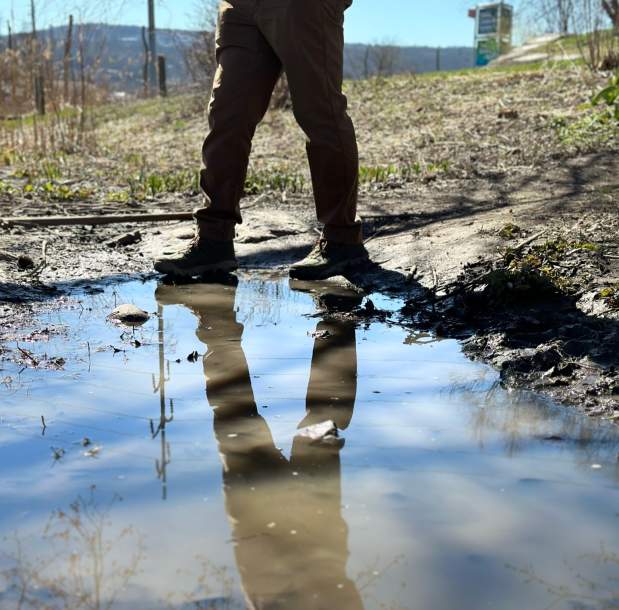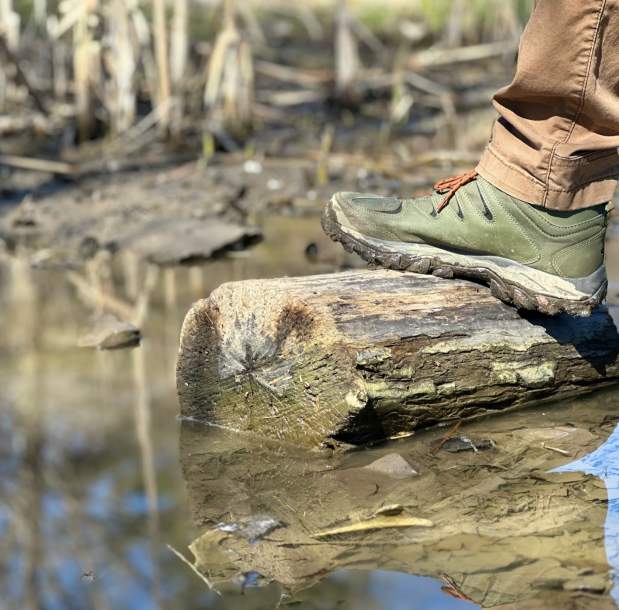Spring in the Northeast brings showers, flowers and … mud.
Ithaca is no exception, with snow melting and April (and early May) showers working together to produce beautiful vernal ponds visible along the many trails open for hiking, and a fair share of muddy walking paths, too.
Taking a walk in nature during mud season is a magical thing. All around you see signs of nature waking up, with early flowers coming up and hearing the return of birds. The increased water flows produce some stunning views of our 150 waterfalls, a surefire time to visit if you want to see them at their rushing best.
One spot not to miss is Taughannock Falls, at the namesake state park along Route 89 in Trumansburg, just outside the Ithaca city area. There is an easy ¾-mile walk to the base of the 215-foot-tall waterfall, which at three stories taller than Niagara Falls is the tallest single-drop waterfall east of the Rockies. Or, for a more vigorous hike, take the North and South Rim trails around the gorge, which are closed for safety during the winter but reopen in the spring.
Buttermilk Falls and Robert Treman state parks pair nicely, as they are about a 5-minute drive from one another. Both feature trails with varying degrees of difficulty, something for every activity level, and stunning waterfalls. Spring provides a quieter time to visit these parks before the heat of summer brings crowds eager to cool off in the lifeguarded swimming areas at the base of waterfalls.
Typically open mid-April through October, the Cascadilla Gorge Trail is nestled in the heart of the City of Ithaca, with one trailhead 5 minutes from downtown’s Commons and the other on the edge of Cornell University’s campus. Walking the historic and stone-covered trail allows hikers to disappear into nature without realizing how close the bustling city is around it.
The Six Mile Creek Natural Area offers creekside walks in the Mulholland Wildflower Preserve, as well as opportunities to view streams, marshland, forested areas, waterfalls, and gorges, from steep cliffside trails that run along both sides of the creek.
The Finger Lakes Land Trust manages the Sweedler Preserve (across the road from the Thayer Preserve) at Lick Brook, with three major waterfalls to see: 25-feet, 47-feet, and 93-feet tall. These are all tucked in a hidden nature preserve that is protected to remain wild and undeveloped. A visit to South Hill Cider makes a refreshing ending to your hike.
The 500-acre Lindsay-Parsons Bio-Diversity Preserve in West Danby features hiking trails along steep hillsides, with views of a diversity of natural habitats, several ponds, and a 20-acre lake.
In Dryden, the Jim Schug Trail is approximately 4 miles along an abandoned rail bed that partially borders Dryden Lake, and leads to the Dryden Rail Trail that continues through into Freeville, Etna, and Varna. It ends at the Dryden town line, where hikers can continue into the Town of Ithaca and eventually the City of Ithaca.
The Town of Lansing has several nice hiking spots, including the Lansing Center Trail, which has several loops with a total of 4.5 miles of trails around the perimeter of abandoned and active farm fields, with shorter linear trails along abandoned railroad berms. In addition to excellent wildlife watching opportunities, the trail also leads to an ice cream stand sure to cap off a walk during warm weather months.
The Edwards Lake Cliff Preserve in Lansing is an off-campus natural area maintained by the Cornell Botanic Gardens. The 84-acre preserve includes forest, thickets, meadows, a gorge with a 35-foot-tall waterfall, and, as the name suggests, lake cliffs.
Another Cornell Botanic Gardens natural area is the Ellis Hollow Wetlands, approximately 25 acres of land along Cascadilla Creek. The diverse terrain here includes forest, old orchard, thicket, and meadows that were once agricultural fields.
For more information about local trails, visit the Ithaca Trails website.
For the kiddos who may not want to go for a long hike, consider the Ithaca Children’s Garden. The Garden, located next to the Cayuga Lake inlet at Cass Park, offers many hands-on experiences for kids of all ages to play and explore in nature, without the walk in the woods.
All of these hikes can be enjoyed during mud season, but there are some guidelines to follow to ensure the trails remain in use for years to come. Following Leave No Trace principles are important when exploring the outdoors year-round, but a few special tips apply during mud season.
As the New York State Department of Environmental Conservation notes, spring weather can be volatile and include rain, sleet, snow, and even thunderstorms can occur, sometimes on the same day. Trails can be muddy, and high, fast-moving water can make stream crossings on trails dangerous.
Here are some guidelines from the DEC to stay safe and protect trails and natural resources:
- Check trail conditions, advisories, and regulations
- Walk through, not around, mud and water on trails to avoid trampling vegetation and widening trails
- Bike only on dry and hardened trails; biking on muddy trails damages tree roots and erodes trails, making them difficult and dangerous for riding
- Banks along rivers and streams can be slippery and rocks may be icy from spray; keep a safe distance away to avoid ending up in water
- Trails are wet, slushy, or even icy in early spring; wear waterproof footwear, gaiters, and crampons
- Carry rain gear and other equipment for various weather conditions
- Return to your vehicle if conditions worsen
- Heed high water warnings and find a safer alternate route or trip
- Avoid all ice on ponds, lakes and other water bodies, as it is thinning and likely covered with water
- Avoid snow/ice bridges over streams; they are weak and likely to give way



